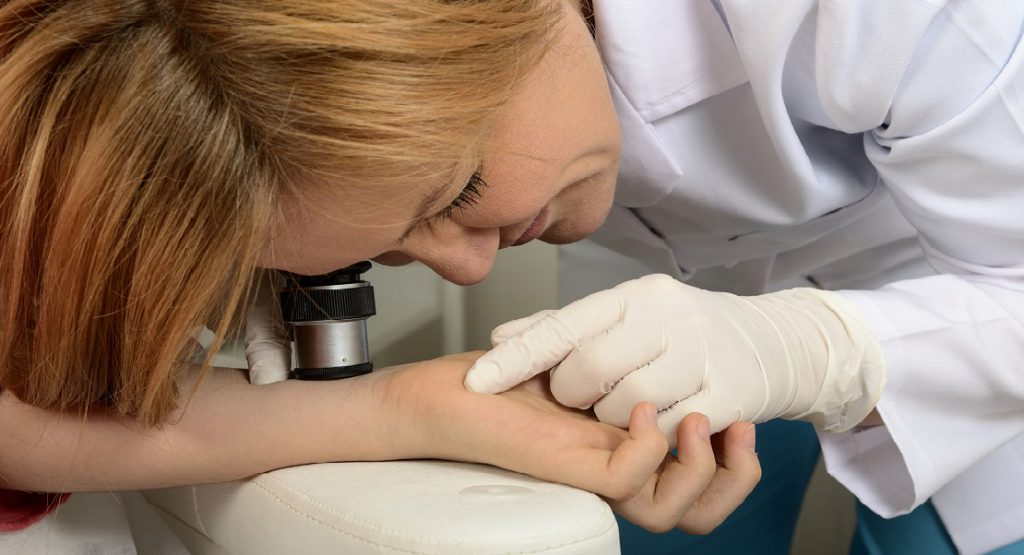Imagine visiting the dermatologist with concerns about a strange growth on your arm. You breathe a sigh of relief when your doctor tells you that the spot is an actinic keratosis (AK), meaning it isn’t malignant…for now. It may stay benign, but it could also turn into a potentially life-threatening form of skin cancer. What?
A staggering 58 million Americans are affected by AKs, but many of them may not know what that means and whether they should be concerned. To clear up the confusion, I spoke with Mary Hall, MD, a board-certified dermatologist practicing in Morgantown, West Virginia.
A Numbers Game
“Not all AKs turn into cancer,” Dr. Hall says, adding that your doctor may also refer to this type of growth as a solar keratosis. AKs that turn cancerous almost always become squamous cell carcinomas (SCC), the second most common type of skin cancer. Untreated SCCs can become invasive, and even life-threatening. Catching and treating the growth before it becomes an SCC can make a huge difference in your treatment experience.
“You want to get them early, before they go squamous, mostly to prevent possible invasion into the skin and internal organs,” Dr. Hall says. “This is especially important in the head and neck region, as those cancers can be more aggressive. You’re also going to get less scarring than if you waited to remove a growth until it was cancerous.”
Only about 10 percent of actinic keratoses will eventually become cancerous, but the majority of SCCs do begin as AKs. Unfortunately, there’s no way to tell which AKs will become dangerous, so monitoring and treating any that crop up is the only way to be sure.
Risky Business
The more ultraviolet (UV) radiation you’ve been exposed to, the greater your chance of developing an actinic keratosis. Whether UV rays come from the sun or tanning beds, they’re causing damage that can contribute to AKs. Areas of the body that are usually exposed to the sun tend to develop more AKs than areas we cover with clothing.
“The most common places I see them develop are the face, lips, ears, scalp, back of hands and forearms,” Dr. Hall says. “You also see them on the shin region, depending on the patient. Women can tend to have those lower extremities more exposed than men do, from wearing skirts and shorts.”
Dr. Hall explained that people with light skin, hair and eyes are at a higher risk of developing actinic keratoses, and that those with freckled faces should be aware of a predisposition as well.
Many Forms, Many Treatments
What does one of these AKs look like? Well, a lot of different things.
“They vary widely,” Dr. Hall says. “They could be thick, red, scaly patches or they could be little — what we call keratotic nodules. They could be red bumps with a tan crust or could present with a raised little horn-shaped part, called a cutaneous horn.”
Dr. Hall says to pay attention to anything that keeps coming back or doesn’t heal, just as you would while examining your skin for signs of fully formed skin cancers.
“I tell my patients that if they have any area like that, to call [the office] and we can get them in right away. That way we can treat them early and prevent squamous cell carcinoma formation.”
Treatment options for AKs run the gamut: Dr. Hall says she usually begins treatment with cryosurgery, but depending on a patient’s preferences and responsiveness, there are plenty of alternatives. Doctors and patients can also decide between laser surgery, photodynamic therapy (PDT), topical medications, curettage and desiccation, chemical peels or a combination of treatments.
“We can do combinations of treatments as well,” Dr. Hall says, “based on the areas of involvement and how many [AKs] you have.”
Is an Actinic Keratosis Serious?
It may seem like identifying and treating AKs is more trouble than it’s worth. After all, there’s nothing wrong yet, right? It’s true an AK is a precancer and may never become malignant. But there’s no way of knowing for sure that a lesion on your skin is an AK, and not a skin cancer. Even if it is just an actinic keratosis, assuming it won’t become cancerous is an unnecessary gamble. If you’re concerned you might have an actinic keratosis, you owe it to yourself to make an appointment with your doctor.





